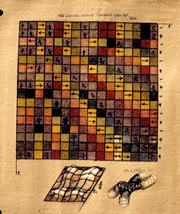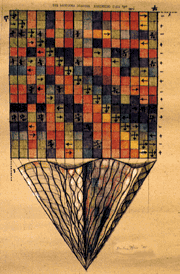RULES FOR LAMBDOMA DIAGRAMS (Continued).
1/6, 2/6, 4/6, 8/6, and 16/6 in the second
vertical column: 1/12, 2/12, 4/12, 8/12, 16/12 in the 3rd vertical column as
opposed to 5/1, 5/2, 5/4, 5/8 and 5/16 in one horizontal row. The other
fractions of the 5th tone could be likened to accidentals in music.
In 3rds
or the fifth place on the undertone axes in distinction from 5ths on the third
place on the overtone axes there are only two vertical bands doubling fractions:
1/5, 2/5, 4/5, 8/5, 16/5 ... 1/10, 2/10, 4/10, 8/10 and 16/10.
The other 6
non-symmetrically arrayed fractions can again be compared to accidental tones in
music...
We can conclude that an encounter between the energy of the vertical
undertone and horizontal overtone produces in the first phase a perfect symmetry
of waves and in the second phase a broken symmetry and in the third phase a
still more fractionated symmetry. If we remember that the overtone is an
infinitely diminishing sequence of progressions increasing in frequency, while
the undertone is a continuing lengthening sequence based on doubling of whole
numbers we have the infinitely small interacting with the infinitely large in
either annihilation or creation depending on whether it is contracting to
annihilation or expanding to creation.
The undertone in its downward
series of fourths takes three horizontal bands doubling by threes, the inversion
of fifths, with the important difference that there are no vertical bands to
counter-balance the one horizontal band of the overtone. This might indicate
that there is nothing to stop the horizontal progression of the vertically based
undertone until we come to the next sequence where as we said there are two
vertical undertone bands which we might assume impede the horizontal thrust... |

